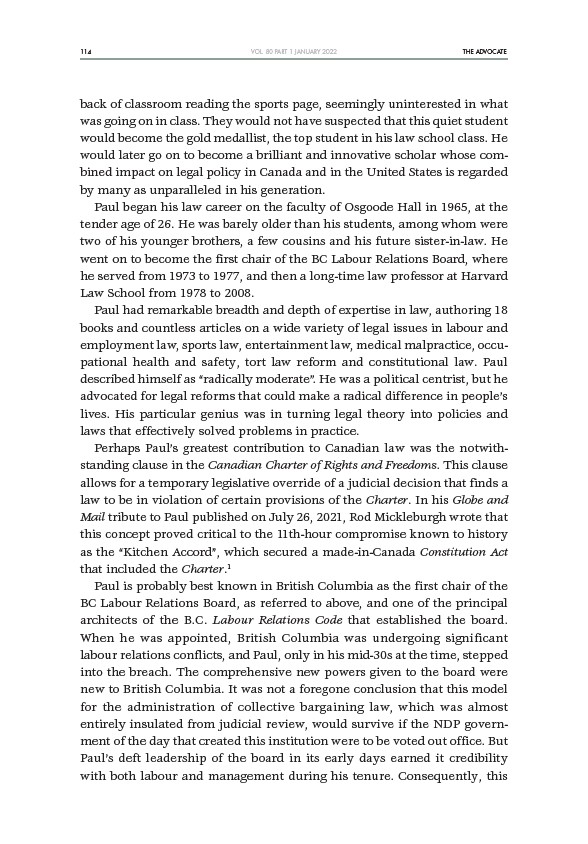
114 THE ADVOCATE
VOL. 80 PART 1 JANUARY 2022
back of classroom reading the sports page, seemingly uninterested in what
was going on in class. They would not have suspected that this quiet student
would become the gold medallist, the top student in his law school class. He
would later go on to become a brilliant and innovative scholar whose combined
impact on legal policy in Canada and in the United States is regarded
by many as unparalleled in his generation.
Paul began his law career on the faculty of Osgoode Hall in 1965, at the
tender age of 26. He was barely older than his students, among whom were
two of his younger brothers, a few cousins and his future sister-in-law. He
went on to become the first chair of the BC Labour Relations Board, where
he served from 1973 to 1977, and then a long-time law professor at Harvard
Law School from 1978 to 2008.
Paul had remarkable breadth and depth of expertise in law, authoring 18
books and countless articles on a wide variety of legal issues in labour and
employment law, sports law, entertainment law, medical malpractice, occupational
health and safety, tort law reform and constitutional law. Paul
described himself as “radically moderate”. He was a political centrist, but he
advocated for legal reforms that could make a radical difference in people’s
lives. His particular genius was in turning legal theory into policies and
laws that effectively solved problems in practice.
Perhaps Paul’s greatest contribution to Canadian law was the notwithstanding
clause in the Canadian Charter of Rights and Freedoms. This clause
allows for a temporary legislative override of a judicial decision that finds a
law to be in violation of certain provisions of the Charter. In his Globe and
Mail tribute to Paul published on July 26, 2021, Rod Mickleburgh wrote that
this concept proved critical to the 11th-hour compromise known to history
as the “Kitchen Accord”, which secured a made-in-Canada Constitution Act
that included the Charter.1
Paul is probably best known in British Columbia as the first chair of the
BC Labour Relations Board, as referred to above, and one of the principal
architects of the B.C. Labour Relations Code that established the board.
When he was appointed, British Columbia was undergoing significant
labour relations conflicts, and Paul, only in his mid-30s at the time, stepped
into the breach. The comprehensive new powers given to the board were
new to British Columbia. It was not a foregone conclusion that this model
for the administration of collective bargaining law, which was almost
entirely insulated from judicial review, would survive if the NDP government
of the day that created this institution were to be voted out office. But
Paul’s deft leadership of the board in its early days earned it credibility
with both labour and management during his tenure. Consequently, this